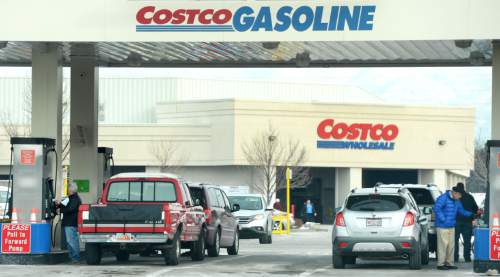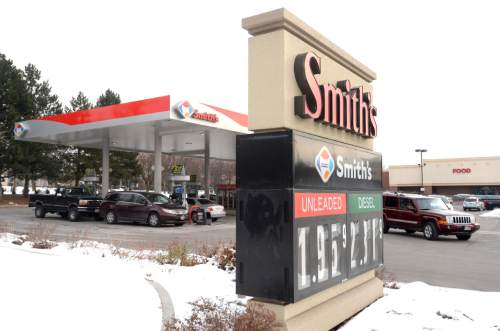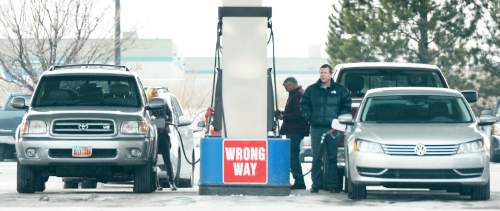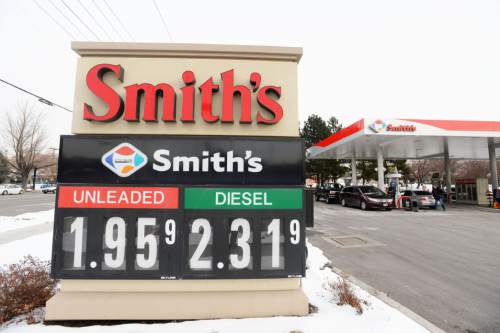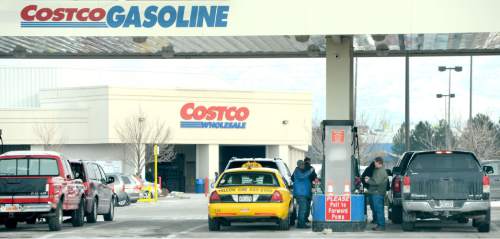This is an archived article that was published on sltrib.com in 2015, and information in the article may be outdated. It is provided only for personal research purposes and may not be reprinted.
Gasoline prices often rise and fall without warning. But here's a good bet: They will go up by about a nickel a gallon Friday.
On New Year's Day, a newly passed increase in the state's gasoline and diesel taxes takes effect.
The increase of 4.9 cents a gallon will be the first since 1997. The State Tax Commission estimates it will generate about $76 million a year, with 70 percent going to the state for highways and 30 percent to cities and counties for local roads.
—
Pump price • Gasoline retailers are a bit coy about whether they will pass the tax hike on to consumers immediately.
"I don't think there is probably a universal answer to that. I would imagine that it's almost going to be on a retailer-by-retailer basis," said Dave Davis, president of the Utah Food Industry Association, which represents many large grocery chains that operate gasoline stations.
John P. Hill, president of the Utah Petroleum Marketers and Retailers Association, said the owners of smaller gasoline stations in his group will probably follow whatever the large grocers and retail chains do.
"They tend to follow Smith's and Costco," Hill said. "Smith's really is the price setter in this market" because of discounts it offers as rewards to shoppers. If Smith's doesn't pass along the tax increase, then smaller competitors nearby may figure they cannot do so either.
Davis added, "It is such a price-sensitive market that oftentimes people are looking around to see what is happening in the market and will adjust prices" based on what their neighbors do.
The tax hike comes from HB362, sponsored this year by Rep. Johnny Anderson, R-Taylorsville — the same law that allowed counties to put Proposition 1 on the ballot to raise sales taxes for transportation, which passed in 10 counties and failed in seven.
The state portion of the gasoline tax will rise from 24.5 cents per gallon to 29.4 cents.
The federal government charges a separate gasoline tax of 18.4 cents.
—
Inflation losses • As the bill was debated, the Utah Transportation Coalition — formed by the Salt Lake Chamber, cities and counties — argued that the current cents-per-gallon tax had lost 40 percent of its buying power because of inflation since it was last increased in 1997.
It said the 24.5 cents tax passed in 1997 is worth 14.7 cents today.
On top of that, Carlos Braceras, executive director of the Utah Department of Transportation, said Monday that all of the 1997 gasoline tax hike — 5.5 cents per gallon — was earmarked for large construction projects designed to increase highway capacity, such as rebuilding Interstate 15 in Salt Lake County.
"You have to go back to 1987 for the last time a gas tax was passed to support the operation and maintenance of the state highway system," he said. "We've been operating it on a declining dollar since 1987; that's 29 years."
The new law alters the gasoline tax so it may increase automatically without any more action by the Legislature.
It's a bit complicated, but here is how it works: The tax technically becomes 12 percent of the wholesale price of fuel, more of a sales tax than a flat cents-per-gallon tax. So if gasoline prices rise, so will the tax.
The law also says the tax will not go below the new 29.4 cents-per-gallon level.
The tax will be adjusted once a year — effective Jan. 1 — by multiplying 12 percent times the average wholesale gasoline price for the previous three years. The law also sets a ceiling of charging no more than 40 cents per gallon in the future.
—
State spending • Braceras is happy that the new tax increase will bring about $55 million more a year to UDOT, and he says it will go to rural highways and bridges.
He explains that because of dwindling buying power from inflation through the years, the state realized about nine years ago that "we did not have enough money to maintain all of our roads in a proactive way."
So it intentionally stopped maintaining low-volume state highways in rural areas that had fewer than 1,000 cars per day or 100 trucks per day. The money saved went to maintain freeways and high-volume highways. "We would only react to those [low-volume] roads," he said, and fix problems when they occurred.
Braceras said $40 million of the new money will go each year to those long-neglected low-volume roads, enabling the same sort of proactive maintenance there that is used on other highways.
He said that will save the state money because every $1 spent for road preservation would cost $4 to rehabilitate roads that have been allowed to deteriorate seriously, or a 25-to-1 ratio to completely rebuild roads that become too bad to be repaired.
"Good roads cost less to maintain," Braceras said.
The state's gamble to ignore low-volume roads in recent years sometimes backfired and will end up costing big money.
For example, earlier this year floods closed I-15 from St. George to Las Vegas. So all traffic diverted for more than a week onto normally low-volume State Road 56 from Cedar City west to Nevada — where little maintenance had occurred.
"That road was completely torn up," Braceras said. "We've applied for federal disaster-relief money. We received a little bit, but nowhere near" what was needed to fix it.
Another $15 million or so of the new money will go annually to maintain and replace bridges around the state, another area in which the state had been falling behind, Braceras said.
"It's not very sexy, but it's a responsible way to spend the money," the UDOT boss said. He adds that he plans to report every year on where and how the extra gasoline tax money is spent.
"I can appreciate the public's concern any time a tax is raised," he said. "I want the public to be able to see where its money goes, how it is used and what the results are."
—
Local money • Meanwhile, city and county leaders said during debates that the gasoline tax hasn't paid for their total road costs in decades. Many said local roads either deteriorated, or some cities and counties raised property taxes or reduced other services to pay for roads — so they said the increase is needed.
Some cities and counties also will get extra money for roads from Prop 1. In the 10 counties that passed it, sales tax will rise by a penny for every $4 in purchases, beginning Friday.
In Davis, Weber and Tooele counties, 60 percent of the new tax money goes to cities and counties — but 40 percent goes to the Utah Transit Authority. In rural areas without a transit district, 40 percent will go to cities and 60 percent to counties.
Prop 1 passed in Carbon, Davis, Duchesne, Rich, San Juan, Sanpete, Sevier, Grand, Tooele and Weber counties. It failed in Salt Lake, Beaver, Box Elder, Juab, Morgan, Uintah and Utah counties.
Critics and supporters agree that the UTA portion — and controversy over big executive salaries and bonuses, and extensive executive travel — was the main reason Prop 1 fell short in Salt Lake and Utah counties.
The law allows counties where Prop 1 was defeated or not placed on the ballot to attempt to put it before voters in the future, and supporters say that is under consideration. Potential changes to that law, including possibly allowing a separate vote on funding for UTA, are expected to be aired at the upcoming session of the Legislature.


